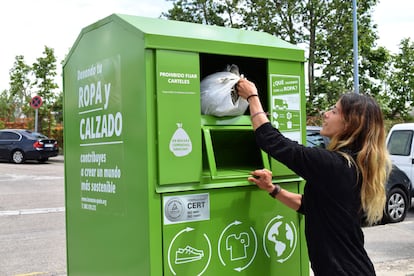Big clothing brands are looking the best way to promote the collection and recycling of used clothingthe vast majority of which now ends up in landfills. A dozen companies will launch a pilot project in six municipalities in April to test the effectiveness of various methods, from placing containers on the street – as already exist in some cities – to taking them to fashion stores, recycling points and even parishes or shopping centers. The initiative arises when the Government plans to approve a decree to force these entities to reuse what they produce, while on January 1 all municipalities will have to collect textile waste in a differentiated way. The sector advances that these changes will lead to growth in second-hand stores and a boom in garment recycling plants.
According to the report Analysis of the collection of used clothing in Spain As of 2021 – latest data available – in Spain, around 900,000 tons of clothing are discarded per year, and 88% end up in landfills; Only 12% goes through a recycling process (with great variations by community: in the Basque Country it exceeds 24% and in Extremadura it does not reach 3%). The data is prepared Fashion re-a social entity of Cáritas that takes charge of around 40% of that market. The Ministry for the Ecological Transition does not have different figures. Meanwhile, the Commission estimates that The EU generates 5.2 million tons of this type of waste per year (about 12 kilos per person per year), of which around 22% is treated correctly.

Sources from Teresa Ribera’s department indicate that the Executive is waiting for the modification of the Waste Framework Directive —which will arrive shortly— to then prepare a decree that will force the textile sector to collect its waste and surpluses. Its approval is expected before next summer. This decree will force the creation of Collective Systems of Extended Responsibility of the Waste Producer (Scrap), a figure that brings together manufacturers and that already exists in sectors such as plastic (Ecoembes) or glass (Ecovidrio).
While it arrives, ten major clothing brands—Decathlon, El Corte Inglés, H&M, IKEA, Inditex, KIABI, Mango, Primark, Sprinter/JD and Tendam—have just launched the first fashion Scrap, which they have named Reviews. “Scrap is a key tool to move towards circularity and responsible management,” considers Ecological Transition. When the standard is published, other brands will be able to join that entity or create others. “We are going to launch a pilot test in six municipalities (large, medium and small) to increase the flow of second-hand textiles,” explains Juan Ramón Meléndez, general director of Re-viste. They are still negotiating with the Spanish Federation of Municipalities and Provinces what they will be, but they estimate that, in total, it will reach about 300,000 people.
“The idea is to test four collection methods: containers on the street (as there already are in some municipalities), clean points, clothing and footwear stores, and other places such as parishes or shopping centers. And do it for a whole year to see the effect of the changing seasons—when more clothes are thrown away—and of tourism,” Meléndez continues. In his opinion, “in an urban area it may make more sense to go to the clothing store, which is at hand; In medium-sized cities it may be the shopping center, while perhaps in a town the parish church makes more sense.” They also want to measure what happens in some places that already have clothing containers on the streets.
The entity will launch campaigns to raise awareness among citizens. “Until now, people thought that only clothes in good condition had to be recycled, but it is important that all used clothes go through this circuit, including those that are in bad condition,” says the director of Re-viste. “It is essential to put these garments in a closed bag, to protect them from humidity and make it easier for the shoes or socks to arrive together, and take them to the nearest container or point,” he adds. Ecoembes often receives criticism from environmentalists for not recycling enough packaging. Will it happen with Re-viste? “We will try to learn from what already works so that our Scrap is efficient and works well from the beginning, and becomes comfortable for both citizens and municipalities,” he responds.
New treatment plants
Manuel León, coordinator of Moda re-, believes that this change will greatly promote this type of treatment infrastructure: “We hope that Scrap will pay the recycling plants for each kilo of clothing treated, which will help sustain them and “It will allow us to grow and process more and more clothes.” Currently there are less than ten facilities to carry out these tasks in all of Spain. “If we increase the percentage of clothing to be reused, which now does not exceed 12%, dozens of new plants will be needed,” he ventures.
Each facility receives tons of garments, which it sorts. In the current distribution, around 10% of the clothing is considered in very good condition and is then sold in second-hand stores; another 70% is usually exported (especially to Africa and the Middle East), while another 10% is separated into yarns to generate recycled yarns. The rest is burned, in what is called energy revaluation. “Our intention is that in the future all the material is reused and reused in Spain; If it is exported, it should be to be sold as second-hand, not to end up in a landfill,” says Meléndez.
The treated clothing that is in better condition ends up in second-hand stores in Spain. Fashion re- It has about 170 —both its own and in supermarkets—, human She has 50, while some social entities also sell reused dresses. OxfamOn the other hand, it tried to open nine stores but closed them in 2018 (it maintains them in other countries). “In Spain we did not achieve the expected results. In other countries, one of the keys is the reduced VAT for second-hand goods,” says Paco Juan, from Oxfam. León points out: “Although young people increasingly buy used clothesWe are still far from countries like the United Kingdom or Germany. In the city of London alone there are thousands of stores of this type, while in Spain we do not exceed 300. There is still a lot to do, let’s hope that changes from next year.”

In addition, starting next January 1 the waste law requires that all municipalities – even small ones – have separate collection of textile waste. In many large cities they are already common (according to the latest count there are about 21,000, almost all of them from social entities), but the majority of medium and small ones are leaving it for last. “The rule requires that at least 50% of this collection be done by insertion or non-profit companies, and for now many municipalities are not bidding for it that way. We have taken many of them to court,” concludes the Moda re- coordinator.



